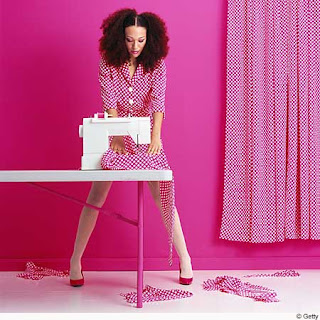 Those who have sewn with me know my catch phrase is manage your frustration! I say it to myself, I say it to my students. I wish it were something that was more fun, like 'make it work' or something more motivating, like 'just do it' but somehow it seems to apply.
Those who have sewn with me know my catch phrase is manage your frustration! I say it to myself, I say it to my students. I wish it were something that was more fun, like 'make it work' or something more motivating, like 'just do it' but somehow it seems to apply.I have been teaching myself to quilt for the past three weeks. I have quilted small projects before but I have never embarked on anything remotely like what I have in mind. I have been going through books and internet tutorials and trying techniques, ripping seams, learning about what foot to use, what needle to use, what thread to use and much much more. There have been a million frustrating moments. I wanted to scream tonight when my bobbin ran out of thread in the middle of topstitching a complicated block. I've misplaced pieces and cut some wrong - in a nutshell, I've been dealing with a high level of frustration. The benefit of all this is that I am learning new things about my sewing machine and I am building skills.
One thing I have had to do as part of this process is change needle frequently. The different thicknesses of fabric require different needles and I have also been mixing knits and wovens. Luckily I am pretty well stocked up different needles right now. I also happened to grab a pamphlet with a needle guide in it and it has been very useful. Schmetz has great info on their site too.
The sewing machine is thought to have been invented in the late 1700s but it wasn't for another fifty years that a simple change to the needle was made that made the commercialization of the sewing machine possible. Hand sewing needles have the eye (the part where the tread goes through) on the dull end of the needle. Sewing machine needles are the opposite: the eye of the needle is near the point. This is known as the Howe needle after Elias Howe who patented the eye-point needle in the 1846.
I'd suggest changing the needle after every four or five hours of sewing and also I would change it depending on what I'm sewing. If you haven't put the full amount of time on it - don't throw it away, keep it off to the side (I keep an empty needle case when I'm rotating them out during a project). If it is time to dispose of it, I put mine in an old prescription bottle instead of throwing it into the trash. And use the right needle for the type of fabric you are sewing on: a universal needle for quilter cottons (an 80/10) a stretch or ballpoint needle for knits, a 70/10 for finer fabrics (like silk), I have heard some people prefer to use a jeans or topstitch needle for sewing cotton or natural fibers because the universal needles have a slight ballpoint and are intended for blended fibers. The best way to find out what is the right needle to use is to test it on a sample of the fabric you are going to sew. But the buck doesn't stop there - you will have to also use the right thread.
Do I sense another post in the future? Indeed I do!

No comments:
Post a Comment